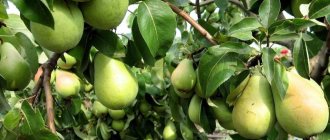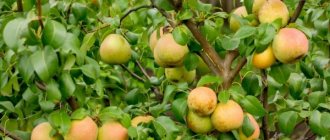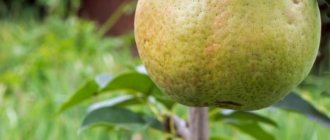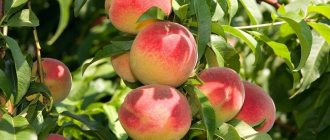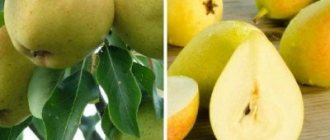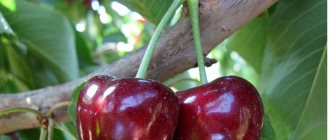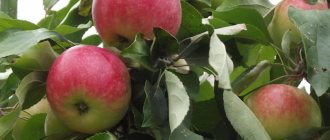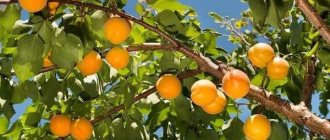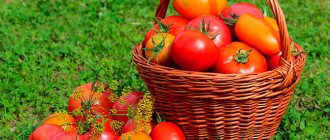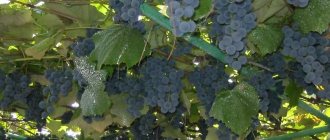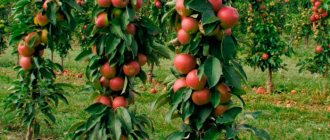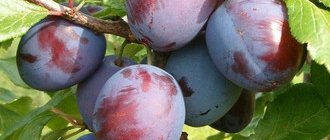Gardening » Pear
0
3351
Article rating
Kira Stoletova
Self-fertile varieties of pears are self-pollinating pears, they can grow separately, bear fruit successfully and produce a decent harvest. In the article we will look at what self-pollinating varieties exist and how they differ from each other.
Characteristics of self-fertile varietal pears
Popular varieties
When choosing a pear for your garden, it is important to understand what qualities you need to pay attention to, and this is not only self-fertility, but also frost resistance, ripening time, yield, fruit characteristics, taste.
Many years of work by breeders have made it possible to develop self-fertile varieties that have a range of advantages that will satisfy the requirements of many gardeners.
The summer early ripening variety was bred at the Academy of Timiryazev K.A. Perfect for cultivation in the middle zone. It is characterized by high frost resistance. It begins to bear fruit 3 years from the moment the seedling is planted. Fruitful, after 6-7 years from the moment of planting it produces 35-45 kg of fruit, which ripen in mid-July.
Fruit
The fruits are not large, 110-130 g, with pale yellow thin skin, with a faint blush. The structure of the pulp is dense and has a sweet-sour taste. The fruits are suitable for storage for two months at a temperature of 2-5°C.
Peculiarities
Among the disadvantages are:
- poor transportability;
- fruit shedding;
- poor tolerance to prolonged drought.
Lada is self-fertile, but if grown in proximity to other pear trees, the yield increases by 10-15%. The quality of the fruit also improves depending on which pears grow nearby. For such purposes, it is practiced in the garden to plant or graft Rogneda, Skorospelka, Chizhevskaya, Pamyat Zhegalov to the main tree.
Prominent
Brought out as a result of pollination of the hybrid VI-53-67 with a mixture of southern pear species. Absorbed the best qualities. Designed for cultivation in the Central region. It is classified as mid-season, ripens from mid-August to the end of September. Maturation is gradual, extending over 1-1.5 months. It is characterized by high productivity; more than 50-60 kg of fruits are collected from one mature tree.
Fruit
The fruits grow weighing from 150 to 220 g, symmetrical, elongated, green to yellow in color, with a slight blush on the side, the skin is dense with a distinct tuberosity, the taste is sweet. The pulp has a homogeneous structure, graininess is not visible. Suitable for fresh consumption, cooking and processing into confitures and jams. A distinctive feature is a very small seed nest, with 4-5 seeds.
Peculiarities
Popular in commercial cultivation to supply the fresh fruit market. It has good transportability and a beautiful presentation, but has a short shelf life (up to 2 weeks).
Chizhevskaya
The variety will please you with its productivity
One of the best self-fertile varieties of summer ripening pears. It is characterized by high and regular productivity and early fruiting. Does not require maintenance, is resistant to low winter temperatures. It blooms in mid-May, which reduces the chances of frosting of the color and ovary. Suitable for growing in the middle zone with a temperate climate.
Fruit
The first fruits appear 3-4 years after planting the seedling or grafting. Characterized by regular high yields. One tree can ripen 55-60 kg of pears. Ripeness is reached in August. The fruits are smooth, pear-shaped, reaching an average weight of 130-155 g. The skin is smooth, no tuberosity is noted, green in color, with a yellow tint at the moment of full ripening. They have a distinct taste, sweet, with a high sugar content of 9.5%. The pulp is homogeneous, pale yellow in color, the structure of the fruit is oily, moderately juicy.
Peculiarities
Among the advantages are noted:
- good transportability;
- can be stored for up to 4 months;
- the fruits do not fall off;
- drought and frost resistance.
The disadvantages of the Chizhevskaya pear include a tendency to reduce the size of the fruit after reaching 25-30 years of age.
What late varieties are there?
Some people prefer to plant winter varieties whose fruits will ripen in late autumn.
Miraculous
The most popular winter pears include Miracle, which is resistant to disease and frost. Flowering begins in early March, and fruit ripening begins in October. The weight of the Miraculous fruit is 180-220 grams.
Pervomayskaya
The main distinguishing feature from other pears is the storage duration of the harvested crop, which is 250 days. Other advantages of Pervomaiskaya include frost resistance, ease of cultivation and productivity.
Rossoshanskaya late
This is a vigorous tree with a branched crown and large fruits. The first harvest is harvested in the third year of growing the fruit tree. The weight of each ripe fruit is 200-250 grams.
Belarusian
Compact pear tree 3-4 meters high. This variety was bred by Belarusian breeders for cultivation in regions with an unfavorable climate. The fruits are juicy, fleshy, with white sourish pulp.
Olivier de Serres
This variety is rarely grown, as it is capricious and requires careful care. In summer, many branches appear on the tree, which reduce the yield. Experienced gardeners advise periodically pruning Olivier de Serre.
Bere Ardanpont
A late-ripening fruit plant in which ripening begins at the end of July. The advantages of Bere Ardanpon include high yield, large fruit size and frost resistance.
Dessert varieties
Dessert self-fertile varieties gained their popularity among gardeners due to the high levels of sweetness and juiciness of the fruits of such fruit trees. But among all the dessert varieties, the best ones are:
Veles
Autumn variety, bred as a result of crossing Forest Beauty and Venus. In a short time it has gained popularity among many gardeners due to its beautiful shape and high taste characteristics. Velesa (Daughter of the Excellent) easily tolerates winter frosts down to -25°C, but is prone to freezing at a young age during spring frosts. Suitable for growing in temperate continental climate areas.
Fruit
The fruits have an average weight of 180 g, but in the first years larger specimens weighing more than 200 g are observed, they are distinguished by their round shape with a flat and smooth surface, and ripen in September. The skin color is green with a distinct orange-red blush. The pulp is dense, juicy, homogeneous, pleasant to the taste.
Peculiarities
The trees are medium-sized with well-developed skeletal branches, the crown is pyramidal. It begins to bear fruit at 5-6 years. Veles can be stored well for 4-5 months. For industrial purposes they are used to make jam and juices, sometimes as raw materials for candied fruits.
Otradnenskaya
Fruits are good for processing
The autumn ripening variety was developed as a result of crossing Tema and Forest Beauty. Easily tolerates low temperatures. Rarely affected by diseases and various pests.
Fruit
The fruits are not large, 100-130g, round in shape. The skin has a base color of green, but gradually turns yellow with a vague red blush. Small subcutaneous dots can be traced, weakly expressed. The pulp has a sweet and sour taste, weak aroma, fine-grained.
Peculiarities
Otradnensky pears are low-growing, standard. They begin to bear fruit in the 3rd year. Productivity is regular and stable, 30-40 kg/tree. Shelf life after collection is 100-120 days (at 0-3°C). The fruits have a good presentation, are suitable for long-term transportation, and are resistant to mechanical damage. One of the best self-fertile varieties for industrial cultivation and processing.
Characteristics of the climate zone
The Moscow region is located in a zone of temperate continental climate, which is characterized by a large annual amplitude of air temperature, as well as significant changes in temperature indicators throughout the day and uneven distribution of precipitation. Frosty winters, very hot summers, and return frosts in late spring make it difficult to grow such a fruit crop as a pear, since the buds are laid in the previous summer, and there is a high probability of them freezing in the winter.
Therefore, owners of garden plots or summer cottages should take into account that in such conditions, frost-resistant, resistant to sudden temperature fluctuations and vagaries of weather, early ripening, self-fertile varieties and hybrids will fully grow and develop.
Columnar varieties
Columnar fruit trees have gained great popularity among gardeners in recent years.
Due to their compactness, they are ideal for garden plots with a minimum area and are particularly decorative during the flowering and fruiting period. Among this type of pear there are also self-fertile varieties that are worth paying attention to.
Decor
This is a columnar, self-fertile pear that grows up to 2 m in height, and begins to bear fruit in the second year after planting the seedling. Belongs to early autumn, the fruits begin to ripen at the end of August. The yield is stable, you can collect 8-10 kg of fruit.
Fruit
Decor is a large-fruited variety, pears weigh on average 230-250g. The skin is smooth and has a beautiful golden color; there is no blush. The pulp is juicy, homogeneous, white. The fruits are sweet with a delicate dessert taste. Often used in cooking.
Peculiarities
The following advantages are noted:
- early fruiting, bears fruit in 2 years;
- frost resistance, freezing is not observed at -30°C;
- resistance to moniliosis and clasterosporiasis;
- compactness, one tree needs 3 square meters. m. area;
- does not require pruning.
The disadvantage is considered to be fragility and the need to update every 15-20 years.
Gardeners to gardeners
Until recently, pear was considered the second most planted seed crop in amateur gardens.
However, in recent years, when breeders have created many frost-resistant varieties with aromatic, large, honey-sweet fruits, in no way inferior in taste to southern pears, this crop is confidently coming out on top in the central and northern regions.
And this is quite understandable. Firstly, the pear “does not suffer” from the frequency of fruiting, and with good care it annually gives gardeners high yields of tender, tasty fruits. They are both sweeter and more aromatic. And their flesh is more tender and juicy.
Secondly, the pear begins to bear fruit earlier than the apple tree (usually in the third year after planting).
It gives higher yields. This is also due to the biological characteristics of the culture. After all, one pear inflorescence can have up to 20 flowers, while an apple tree can have no more than 6.
Pear is less demanding on soils. It grows well not only on neutral, but also on medium acidic soils.
The pear tree is more durable than the apple tree. With good care, she can live more than 100 years.
The crop is weakly affected by pests and diseases and is never infected with black cancer, which kills entire apple orchards. This allows you to significantly reduce chemical treatments in the garden and regularly obtain environmentally friendly fruits.
The pear has a more active bud awakening and a rather low shoot-forming ability. Therefore, it is much easier to form a crown that will not thicken. She herself already forms a tiered shape, which only remains to be adjusted. And there will be a lot of fruits on each branch.
The pear's root system is taprooted and goes deep into the ground. Therefore, it is more drought-resistant (it gets water and nutrition from the lower soil horizons) and frost-resistant (deep roots are less likely to freeze out).
Among the newest varieties of northern pear there are non-self-fertile, partially and completely self-fertile, which have parthenocarpy (that is, they are able to self-pollinate without the participation of pollinating insects).
But for good cross-pollination, we recommend that you plant two or three different varieties.
We told you about the “advantages” that the pear has. In this article we will talk more about the important features of growing this crop and present you with the best pear varieties from our collection.
BEST PEAR VARIETIES: GROWING FEATURES
about the history of obtaining cultivated varieties of pear, about the beneficial properties of its fruits, about planting and caring for this fruit tree in our published articles:
“Spring grafting of apple and pear trees”;
“How to prune fruit trees”;
“How to care for a pear”;
“Autumn fertilization of fruit trees;
"Autumn planting of fruit trees and shrubs."
Today we will talk in detail about the important points that you need to pay attention to when growing the best varieties of northern pear.
No sun - no harvest. Pear is one of the most sun-loving crops. You must take this into account when choosing a place to plant it. The slightest shading can lead to the loss of almost half the crop. And a pear growing in the shade may not bear fruit at all!
Therefore, choose an area for it that is very well lit by the sun throughout the day. It will grow best on a hill or on a southern gentle slope, since this crop also does not tolerate stagnation of melt, rain and groundwater.
Which “neighbors” are undesirable for a pear . Other crops planted next to it can have a great negative impact on the growth and development of the pear.
A bad neighbor for a pear is a plum, which literally competes with it for sunlight and takes all the nitrogen from the surrounding soil, taking advantage of the fact that it has a more developed and fast-growing root system.
As a result, next to a plum, many pear varieties simply dry out, deprived of light and nutrition for growth. For the same reason, pears do not mix well with cherries.
Pears do not tolerate very well the proximity to currants, especially black currants, which release a large amount of aromatic substances harmful to the pear.
We also do not recommend that you plant a pear with any nut crops, which also suppress its growth and take away its nutrients.
The pear harvest depends on its crown . Breeders call pear leaves a “harvest factory.” And this is a very accurate definition. Moreover, not only the current harvest, but also the future one depends on them. Therefore, the crown should be quite thick (but not thickened!).
However, remember that only those leaves that are fully illuminated by the sun will produce a harvest. But those that are in the shade, on the contrary, take nutrients from the tree.
Remember this feature well when forming the crown! Try to give bright sunshine to all the branches of your tree!
It is important to water the pear on time . Remember that pears need the most moisture in spring and early summer, when the leaves open and flowering begins.
If during this period the trees do not receive enough moisture, they will slow down their growth and begin to shed their ovaries.
However, if the trees do not have enough water in the second half of summer, the fruits will turn out small and not so sweet.
If summer and autumn are dry and hot, at the end of October, before whitewashing the trunks, carry out the last water-recharging watering of the pear orchard. You need to pour 60 liters of water under one tree.
The moisture will nourish all plant tissues and help them withstand winter frosts well.
Don't overfeed pears. Read about the optimal doses of fertilizers when planting in our article “How to care for a pear.”
These fertilizers will be enough for plants for the first three years. If you overfeed the trees, they will begin to “fatten” and will devote all their energy not to the formation of fruit buds, but to the growth of green mass.
Therefore, start fertilizing pears only in the fourth year. Moreover, the older the tree, the greater the dose of fertilizer should be. Give pears nitrogen in the spring, and phosphorus, potassium and microelements in the fall.
Pear loves organic matter very much, so in the spring it is best to feed it with slurry (at a concentration of 1:10). And in the fall, we recommend that you give the trees a ready-made mineral complex for autumn feeding of fruit trees, containing phosphorus, potassium and all the necessary microelements.
The use of autumn fertilizer “Autumn Fertika” gives very good results. It is introduced along the projection of the crown into a circular groove to a depth of 15 cm, and then all the tree trunk circles are abundantly watered.
The best time to plant pears . Many gardeners believe that in the northern regions it is better to plant pears in the spring, thinking that they will take root better over the summer.
However, this is not quite true. And at the beginning of autumn, the weather in most of Russia is warm, the sun is still warm, but it is not so dryingly hot. There are almost two months left before lasting frosts. Therefore, you can safely plant pears both in spring and autumn.
The timing largely depends on your soil and climate zone. But in the northern regions it is best to plant a pear: in the spring - from April 25 to May 15; in autumn - from September 8 to October 5.
It is important that the tree has a month left before the onset of autumn cold for reliable rooting.
To cover or not to cover for the winter? Modern pear varieties have increased frost resistance, so mature trees do not need winter shelter.
But the young ones (in the first 3–4 years) are still better protected from winter frosts by covering the tree trunk circles with dry leaves in a 50 cm layer and laying spruce spruce branches on top in two layers “needles up” so that rodents cannot get to the tasty, sweet wood .
THE BEST PEAR VARIETIES FROM OUR COLLECTION
We told you about the benefits of the pear, as well as some very important features of its cultivation in the northern regions of the country.
Now you can choose the best pear varieties to plant on your site.
We present to you the best and most popular pear varieties from our collection, which you can buy from us and plant today.
Summer varieties: Raduzhnaya, Krasulya, Chizhovskaya.
Autumn varieties: Duchess, Autumn sweet, Chusovaya, Uralochka, Vekovaya.
Winter varieties: Chelyabinsk winter, Aprilka.
You can read more about these varieties on our website or in the “Spring 2021” catalogue.
Self-fertile pear varieties for central Russia
Pear is one of the most popular plants in garden plots. And this is not surprising. After all, what could be tastier than juicy, ripe, aromatic fruit... And all this miracle can be found not on store shelves, but in your own garden.
However, for residents of central Russia, growing pears is a real problem. The fact is that due to the climate, the pear tree freezes in the first year in winter after planting. It was like that before. But now the situation has changed and many gardeners in this region can fulfill their old dream - to grow a pear on their own plot.
This is not magic, but selection. Scientists have developed unique types of pears for central Russia. We will talk about them further. Namely, about self-fertile crops. However, before that, we will find out what characteristics a variety should have for this region.
Pear variety "Velesa"
Mainly an autumn variety. As a rule, it is small in size with a lowered crown in the form of a pyramid with curved arches. It has a cherry-brownish tint, bare and round shoots. The leaf blades are yellow-green, elongated and rounded, with a smooth surface and curved edges.
The fruit reaches a weight of 120 grams and is pear-shaped, with a slightly crooked and curved stalk. A funnel in the shape of a cone with an obtuse angle and a shallow saucer is identified.
Choosing a pear variety for central Russia
So, there are several characteristics that a crop intended for planting in a given region must have: frost resistance, productivity, good taste, fruiting characteristics and self-fertility. Let's look at each sign separately.
Let's start with frost resistance. This is one of the most important points when choosing a plant. If the crop is not resistant to the cold of central Russia, then it is pointless to consider all the other advantages of the variety. After all, the tree will die in the first winter.
Do not believe sellers who convince you that southern pear varieties get along well in central Russia. After all, it is after such cases that gardeners begin to believe that pear trees are not capable of growing in a given region.
When purchasing a seedling, first of all pay attention to whether the tree is frost-resistant, and then ask about other benefits of the crop.
The taste of the fruit is also an important point. Many gardeners claim that even if you grow a pear in central Russia, its taste will not be as rich as its southern relatives. Of course, these conversations are not without meaning.
The best pear varieties: “Vesnitsa”
A typical late ripening variety. This is a medium-sized tree with a crown in the shape of a round neat pyramid and not very dense. The fruits usually weigh about 85 grams. Most are pear-shaped, with a glossy surface.
The fruit is predominantly golden yellow in color. May have a slight orange blush on the southern half of the fruit. The pulp of the fruit is usually tender, not very dense, creamy, with a huge amount of juice.
Summer pear varieties for central Russia
So, it’s time to talk about the best varieties of pears for this region.
The leader among the varieties common in the middle zone is Lada. Fruit ripeness occurs at the end of summer. The fruit size is small. On average, one pear weighs 100 grams. The fruit tastes sweet and sour. The main color of pears is yellow.
However, you can notice a slight pink tint on the sides. Despite the fact that the tree is self-fertile, it would not be a bad idea to plant other varieties near the plant. After all, then the taste of pears will be sweeter and richer. The variety can be called early-fruiting, because pears appear on the tree in the third year after the seedling is planted.
The Chizhovskaya variety is not as frost-resistant as Lada, but in taste and size it is not inferior to its relative. The tree is afraid of sudden temperature changes and changes in soil moisture levels. For example, if a crop grew for a long time in drought conditions, and then the earth became saturated with moisture, then the pears will certainly crack.
In turn, cracking of the fruits can cause rotting of the pears and the appearance of various bacterial diseases. Otherwise the tree is strong. The fruits grow large. The average weight of one pear ranges from 120 to 140 grams. The color of the fruit is yellow.
A clear advantage of Chizhovskaya is that the fruits do not fall off and do not overripe on the tree. Removable fruit maturity occurs at the end of the summer period.
Skorospelka from Michurinsk
One of the best varieties for the central part of the country is Skorospelka from Michurinsk. This plant is ideal for those who like to eat pears in early summer. After all, the ripeness of the fruits begins already in July!
The taste of the fruit is not as rich as the two previous varieties. And the fruits are inferior in size to Lada and Chizhovskaya. On average, the weight of one pear is 80 grams. The advantage of this variety is that the trees are compact and do not take up much space on the site. In addition, the culture looks very neat. The fruits are yellow in color.
Next in line is the Rogneda variety. Removable fruit ripeness occurs in August. In order for the fruits to fully ripen, they need to lie down for a while after picking. The advantage of the Rogneda variety is that it is immune to many bacterial diseases.
The plant is also frost-resistant and does not suffer from sudden temperature changes. Pears are yellow-orange in color. The fruits are quite large in size. The fruits taste sweet, and their aroma is somewhat reminiscent of their southern relatives. Rogneda fruits are characterized by excellent keeping quality.
The harvest can be stored in a cool room for three months. Also, many gardeners claim that these fruits make delicious fruits.
Clapp's favorite pear is characterized by medium-sized fruits. The peel of the fruit is quite dense. The fruits themselves are yellow. Pears are also decorated with a pinkish blush. They taste sweet and sour. The fruit inside is juicy, tender, and melts in your mouth.
It is impossible not to talk about such a variety as Duchess. The fruits grow small. Their skin is dense. The fruits are colored and yellow-green with a burgundy blush. Duchess is distinguished by dark red dots on the sunny side. Pears taste sweet, but you can notice a subtle sourness. The fruit pulp has a yellowish tint and is fine-grained.
We finish our list of summer varieties for central Russia with the well-known Bessemyanka. The fruit is medium in size. The fruits are yellow-green. Later, a reddish blush can be seen on the pears. The taste of Bessemyanka is sweet and juicy. However, the downside of the variety is that it is susceptible to scab.
Mid-ripening pears
To harvest a mature harvest in late summer or early autumn, varieties with medium ripening periods are planted.
Yakovlev's favorite
Among the large-fruited varieties, Lyubimitsa Yakovleva is distinguished, whose pears weigh 240 grams. They are green in color with a slight yellowish tint. The pulp is somewhat harsh and therefore jams are often made from the harvested crop.
Thumbelina
A mid-season plant whose fruits ripen in the first half of September. The weight of the mature harvest is 70-85 grams. The surface of the fruit is covered with a golden peel with a yellow tint. Thumbelina is grown for making compote and jams.
Saratovka
Such trees are classified as medium-sized plants, since their height is 2-3 meters. Saratovka fruits are orange in color, they have juicy pulp with a sweet aftertaste. The advantages of the crop include long-term storage and resistance to rotting.
Lyra
Trees of this variety have a pyramidal trunk, colored brown. In the second half of spring, leaves form on the branches, which have a smooth surface and an elongated shape. The fruits ripen at the end of September and weigh 170-180 grams.
See also
Rules for treating pears with iron sulfate in the summer, its differences from copper sulfateRead
Domestic
A tall variety, the trees of which grow up to ten meters in height. They have straight branches and a spreading crown. The domestic pear crop has an attractive appearance and is therefore often grown for further sale. Harvesting takes place in late September or early October.
Veles
Harvest ripening begins in June and lasts until the end of August. The average weight of pear fruits is 150-200 grams. Until the end of summer, pears are colored bright green, and after ripening their surface turns orange-red. The yield per tree is 80-90 kilograms.
Muscovite
Tall Muscovite fruit trees grow up to 7-9 meters in height. They have a spreading brown crown. The leaves of Moskvichka are oval in shape, with a slight bend in the central part. The first fruits appear on the trees 2-3 years after planting the seedlings.
Marble
The characteristic features of the Marble Pear are considered to be tall trees over 10 meters high and their dense crown. Ripe pears are covered with a dense peel, on the surface of which there are dark orange dots. The pulp is juicy, tender and grainy.
Autumn varieties of pears and their characteristics
There are autumn self-fertile varieties of pears for the middle zone. In this region, the autumn period is quite cold. Therefore, planting such pear varieties is quite a risky business. The most suitable self-fertile autumn crops are Bere Moskovskaya and Naryadnaya Efimova.
Bere Moscow is a fairly young culture. It is distinguished by remarkable frost resistance. The tree is also immune to many diseases, such as scab. The taste of the fruit is sweet and sour, but it has no equal in softness and juiciness. Removable fruit maturity occurs in October. Pears are colored yellow-pink.
The pear with the interesting name Naryadnaya Efimova belongs to the early autumn varieties. The frost resistance of the crop is excellent, and resistance to various diseases is also excellent. The fruits have a regular, elongated shape. The fruit size is average. The color of the fruits is yellowish-greenish. On the sunny side you can often notice a pinkish blush. To taste, Elegant Efimova is quite sweet.
It is worth saying that Moldovan, Western and Central Asian varieties are not able to take root in this region. If the temperature drops below - 25 degrees C, the tree dies.
Thus, thanks to the work of modern breeders, many self-fertile varieties have been developed for the middle part of the country. Which of these are the best varieties for your garden is up to you to decide. And we can only wish you good luck in this difficult matter!
Pear variety “Bryansk beauty”
A characteristic variety that ripens in late summer. It is a small tree with slow growth and a loose ball-shaped top. It has neat, brownish-brown tint, jointed, open and oval sprouts. The ends are directed vertically. Leaves are dark green. As a rule, they are elongated, with a smooth, glossy surface.
Pears grow weighing 200 grams. They have a pear-shaped and slightly elongated shape. Pears are golden yellow in color. They also have a slight pink tint to the tan along the south side of the fruit.
Pear variety "Irista"
A variety characteristic of early autumn. It is a medium-sized tree. It is usually distinguished by its small stature. The leafy crown is in the form of a reverse pyramid, that is, upside down. The leaves are usually medium in size, as always, elongated, egg-shaped.
The fruits usually weigh approximately 155 grams. Regular, broadly pear-shaped without a characteristic funnel. The fruit is usually green at harvest. They also acquire a slight tan of a pinkish tint from the southern position of the pear tree. But a week after the start of storage, the fruits become greenish-yellow in color. Because a pinkish tan appears on 60% of the surface of the fruit.
The sweetest varieties
Most ripe pears have a sweet taste, but there are varieties that will be no less sweet even when unripe.
Prominent
The variety is productive, early-fruiting, universal, winter-hardy, and scab-resistant. The ovaries are characterized by high frost resistance. The tree is vigorous, the crown is narrow-pyramidal. Greenish-yellow, lightly tanned fruits weighing about 150 g have a wide saucer, a narrow and shallow funnel, and a thick short stalk. Semi-oily, juicy, tender white flesh with a good sweet taste.
The fruit cannot be stored even for several days; it is recommended to can it or immediately consume it fresh.
Buttery sweet
A universal variety to use, suitable for long-term storage, easy to care for, and disease resistant. Pears with a high concentration of sugar are not only consumed fresh, but also made into liqueurs, wine, and preserves.
A summer self-fertile variety with excellent taste - Children's pear.
The pear tree is one of the most popular fruit trees among amateur gardeners.
Scientists at breeding institutes are breeding more and more new pear varieties by crossing different varieties and hybrids.
One of these varieties is the “Children’s” pear variety.
…
Depending on the time of fruit ripening, pears are divided into summer, autumn and winter. Pear variety "Children's" is a summer variety. The fruits of this variety ripen in the summer, from mid-July to mid-late August.
Summer varieties also include Duchess, Chizhovskaya, Carmen, Moskovskaya rannyaya and Orlovskaya Letnyaya.
History of selection and region of breeding
The “Children's” variety was bred by famous breeders Yu.A. Petrov and N.V. Efimova at the All-Russian Selection and Technological Institute of Horticulture and Nursery Science (VSTISP), Moscow.
The variety was obtained by crossing interspecific hybrid No. 8 with the Duchess summer pear variety.
Basically, the variety is distributed in private plots of Moscow and neighboring regions. This variety is zoned in the Central region.
The pear varieties Gera, Cathedral, Krasnobokaya, Elena and Vernaya grow well in this region.
Pear "Children's": description of the variety and photo
The height of the tree is high, and the “Children’s” pear is distinguished by its durability. Their pyramidal crown consists of few but powerful branches with many ringlets; fruiting is concentrated in them.
The shoots of the tree are straight, thick, light brown in color. Dark green leaves with finely crenate edges are smooth and oval in shape.
The fruits are medium-sized (about 80 g), pear-shaped. They have a yellow color as the main color, and the cover color is a pinkish-orange blush.
You can get acquainted with the variety in more detail and see the “Children’s” pears in the photo below:
The productivity of the "Children's" variety is regular and high. Fruiting begins in 4-5 years under favorable conditions.
The varieties Noyabrskaya, Lada, Pamyati Zhegalova, Yakovlevskaya and Vernaya are also high-yielding.
The variety is considered an early summer variety because the fruits appear earlier than on other trees.
From mid-July to the end of summer, pears of this variety delight owners with their harvest. It is necessary to ensure that the fruits do not overripe on the tree and to remove them during the period of noticeable ripening.
The pulp of the fruit of the variety is very juicy and sweet. The fruits are universal in use. They are consumed fresh, and compotes, preserves and jams are made from them. They keep well in the cold. They can remain edible in the refrigerator for about one month.
The "Children's" variety is frost-resistant. Trees are able to survive low temperatures without any consequences. They also tolerate spring frosts after a thaw well. They are able to survive high summer temperatures. Trees of this variety are not in danger of dying during drought.
The “Children's” variety is self-fertile, so trees do not require additional pollinators to bear fruit.
The varieties Osennyaya Yakovleva, Mramornaya, Lira, Moskvichka and Lesnaya Krasavitsa also tolerate different weather conditions well.
Planting and care
- Planting Planting a seedling purchased from a nursery in a permanent place is one of the fundamental stages.
Depending on how correctly the tree was planted, its life will proceed.Proper planting of a seedling favors the successful development of the tree; the timing of its fruiting and the taste of the fruit largely depend on this.
Therefore, special attention should be paid to this process.
When buying a seedling, it is worth remembering that annual plants take root best. The roots of annual seedlings are less damaged during transplantation.
It is best to plant in early spring, as soon as the ground has thawed enough to dig a planting hole. If the seedling is purchased in the fall, you can simply dig it in until spring.
If planting was planned earlier, the holes should be dug in the fall so that the soil in it settles. For the “Children's” variety, it is permissible to plant in the fall, because the variety is frost-resistant, and low temperatures cannot damage the seedlings.
First you need to choose a place in the garden. It should be well lit and with a low groundwater level. A very wet place is not suitable. The roots of the tree should not be constantly in water. This will lead to their rotting.
You need to start planting by digging a planting hole 50-60 cm deep and about 1 meter in diameter. The root system of the tree will grow in the hole for the first few years, so it should be provided with all the necessary substances.
To do this, you need to add a dressing of fertile soil and humus (1 bucket) to the pit. For faster and more proper growth, you can add 200 g of superphosphate, 50 g of ammonium nitrate and 100 g of potassium sulfate.
IMPORTANT: You cannot use fresh manure instead of humus. It will cause the roots of the tree to burn.
After the hole has been dug and filled with nutrients, a small mound of earth should be placed at the bottom of the hole. Place the seedling on it, carefully distribute the roots over the hill and cover it with soil.
If there are air bubbles in the planting hole, this may cause the roots to rot.
When falling asleep, you need to water the covered ground with water from time to time. It will wash away the soil from the roots, the earth will compact and fill the resulting air voids. Turn crooked seedlings to the south side so that it straightens out as it reaches towards the sunlight.
When the tree is planted, it should be tied to a peg driven nearby. The wind will not shake the seedling, and its roots will remain in a fixed state. This will help him settle into his new place better and faster.
It is better not to trample the soil around the seedling. Heavily compacted soil will retain oxygen necessary for root development.
- Crown formation
The tree of the "Children's" variety is tall. Therefore, it needs crown-forming pruning. Numerous branches and shoots prevent sunlight from penetrating into the tree crown. This slows down the growth of flowers, delays the onset of fruiting, reduces yield, and worsens the taste of the fruit.The formation of the crown must begin as soon as the seedling has been placed in a permanent place. In young trees, the crown can be formed by bending or deflecting the branches. To do this, use spacers or tie the branches with twine. Shoots that grow at an acute angle are corrected with spacers.
And those growing at an obtuse angle are attracted to the trunk, tied with a rope or wire. The tree bark should be protected with pads made of hard material.
Subsequently, they take root at the desired angle. Pruning does not have a very good effect on the health of the pear, so this method is more advisable in shaping the crown of the pear.
Pruning is either shortening shoots or thinning branches. The shoots need to be cut off above the bud. Large branches are removed in two stages: first, most of the branch is cut off, and then the remaining part is sawed off.
When the crown is formed, 5-6 skeletal (main) branches are left. Shoots that are located at an acute angle to the stem are not suitable for them. When the pear bears fruit, these branches may break off under the weight of the fruit.
The main branches in the crown of a fruit tree are the branches of the lower tier. For it, 3 shoots are chosen around the circumference of the stem.
The next tier is formed after the branches of the lower one have developed sufficiently and begin to gain strength. To form the 3rd and subsequent tiers, the central conductor is sawed off.
Pruning should be done in the spring, before the plants begin to flow sap, or late in the fall before the onset of cold weather. This must be done with a sharp and clean instrument. The speedy healing of wounds on the tree depends on this.
The crown of a pear takes about five years to form. After the tree is well formed, only so-called sanitary pruning is carried out - old, broken or diseased branches are removed.
- Should it be closed for the winter?
Pear "Children's" is a frost-resistant variety. Mature trees do not need any insulation. Young trees can be insulated: the trunk circle should be covered with suitable materials (peat, sawdust, compost), the trunks should be spudded, and the trunk should be tied with spruce branches. - Watering It is necessary to water the tree when the soil around the trunk has become dry. It is worth considering the groundwater level.
If the soil around the tree is moist enough due to them, there is no need to water it additionally.Excess water leads to rotting of the roots. The disadvantage is that the tree develops poorly, fruiting is delayed, and the yield decreases.
- Top dressing
Every gardener wants the fruit tree in his garden to grow as quickly as possible and to begin bearing fruit as early as possible. For the rapid growth of a pear and for the speedy start of fruiting, the tree needs to be fed with nitrogen.To do this, you need to scatter approximately 50 g of ammonium nitrate around the tree trunk and dig it up. The saltpeter crystals will dissolve due to moisture and will be beneficial.
It is also recommended to feed the tree with sodium humate. This must be done three times: during bud break, then in July, and then at the end of August. This promotes the growth of shoots and foliage.
Diseases and pests
Pear "Children's" is resistant to various fungal diseases. But it can be damaged by various insect pests - pear moth, pear mite, pear psyllid.
Miraculous, Svetlyanka, Bere Bosk, Tatyana and Svarog are resistant to major diseases.
To combat them, insecticidal drugs are used. These include “Karbofos”, “Metaphos”, “Kelifos”, etc.
Spraying should be carried out on a dry, windless day. This is done in the spring, before the buds begin to bloom. This will help get rid of pests that hibernate under the tree and in its bark. After some time, the tree is sprayed again.
Pests reproduce very quickly. Several generations can form over the summer. They gnaw leaves, spoil fruits, branches and shoots of the tree.
If insects are not controlled, the tree will begin to wither and may subsequently die.
In order to protect your garden from pests, you need to carry out preventive measures annually. You should constantly inspect the bark, leaves and fruits of the tree.
For any changes in their appearance, it is worth spraying the pear. Preventative spraying also helps in the fight against various pests.
In the fall, you need to collect all the fallen leaves and burn them - most pests overwinter in the fallen leaves. You also need to dig up the tree trunk and dig deeply into the soil close to the tree.
For the first five years of a tree’s life, until the bark on the trunk has grown stronger, the trees must be protected from rodents. To do this, wrap the tree trunk with dense material. For example, roofing felt. But the trunk must first be wrapped in newspapers so that the roofing paper does not come into contact with the tree bark.
- Fruit mite This insect sucks all the nutrients from the leaves of the tree. The leaves begin to dry out and fall off.
This negatively affects the formation of fruits and the development of the tree in general.It is necessary to spray against this pest during the growth of buds with the drug “Karbofos” or another intexicide.
- Pear moth This is a small butterfly with dark forewings.
She lays eggs inside the fruit.
The “Children’s” variety is ideal for its activity, because The codling moth is dangerous for summer pear varieties - the fruit has a soft skin and it is easier for it to penetrate inside.
Damaged fruits dry out and fall off.
To combat the butterfly, you need to use various insecticides, dig up the tree trunk in the fall and burn the fallen leaves where the pests go for the winter. You can treat it with benzophosphate.
- Winter moth It lays eggs in cracks in bark and branches or near the buds.
Before the tree blooms, yellow-green caterpillars appear. They feed on pear leaves, flowers and buds. To combat moths, insecticide treatment is used before tree flowering. - Pear copperhead It is a small fly.
Adults and their larvae suck cell sap from the leaves and flower stalks of the tree. As a result of their activity, the flowers die, the ovary falls off and the leaves of the pear dry out. An intexicide is also used to destroy it.
Conclusion
The "Children's" variety pear is very well suited for a personal garden.
The disadvantages of the variety are the small size of the fruit and the need to form a tree crown.
But this is compensated by the excellent taste of the fruit and its versatility.
As well as very early ripening of fruits and abundant fruiting. That is why this variety is very popular among gardeners.
selo.guru
The best pear varieties: “Simply Maria”
Mainly an autumn variety. It is a small tree with active growth. The crown is of slight density, in the form of a wide pyramid at the base. As a rule, the leaves are of typical size, very oblong, with sharp edges.
The fruits weigh 180 grams and are usually pear-shaped. A small and conical funnel with an obtuse angle is identified. Pears are usually light yellow in color when ripe, with a slight tan to a pinkish tint on the southern half of the fruit. However, a week after the start of storage, one third of the fruit becomes light yellow with a pinkish tint of tan.
What does height affect?
Pears, completely different in other characteristics, are grouped into groups according to the height that the tree will reach in its tenth year of life.
Tall varieties
The crown of tall pears begins at a height of 1.5–1.8 m from the ground, and the total height of the tree reaches six meters. Any operations to care for them and harvest are very difficult due to the location of the branches at a considerable height. A representative of tall fruit trees is the pear variety Krasavitsa Chernenko.
Beautiful Chernenko in the photo
Flowering pear variety Krasavitsa Chernenko Pear tree variety Krasavitsa Chernenko
Branch with pear fruits of the Krasavitsa Chernenko variety
In the register of the State Commission of the Russian Federation for testing and protection of breeding achievements, the Krasavitsa Chernenko pear variety is recommended for cultivation in Central Russia. The narrow pyramidal crown of this vigorous tree rises to a height of up to 6 m. It tolerates frosts down to -25 ° C without problems. The productivity of Krasavitsa Chernenko is stable and amounts to 12.7 tons per hectare. The fruits, covered with delicate greenish-yellow skin with a beautiful red blush, weigh up to 200 g each. An important positive quality of the variety is the pear’s resistance to scab.
From the peculiarities of cultivation, I can note that their shoot-forming ability is very poor - to obtain a skeleton, you have to pinch or trim the ends of the branches, and they stubbornly want to look up - to get a better skeleton, you have to bend the branches.
Grandson of Michurin, Michurinsk
https://forum.vinograd.info/showthread.php?t=9506
Medium height
In pear trees classified in this group, the distance from the lower branches to the soil is from 60 to 150 cm. Pears of this type are more often found in the summer cottages and personal plots of amateur gardeners. The height of these trees does not exceed 5 m. The Vidnaya pear variety raises the branches of its narrow pyramidal crown to exactly this height.
Pear Visible in the photo
Vidnaya pear tree with fruits
Vidnaya pear flowers
Vidnaya pears on a branch
My taste is extremely sweet without sourness. Even hard and unripe ones have an insipid sweet taste. Another point is that this variety bears fruit on ringlets (which, by the way, is also indicated in the description of VNIISPK) you do not have. Perhaps the rootstock has an effect. Or maybe a different variety.
yri Trubchevsk, Bryansk region.
https://forum.vinograd.info/showthread.php?t=9503
Recent Entries
5 working ways to use tar in the garden 7 indoor plants that help you get married even in adulthood Indoor plants that can bloom in trouble
short
The lower branches of such pears are located at a distance of 55–70 cm above the ground, and the tree itself reaches 4–4.5 m in height. The late Belorusskaya pear gives a good idea of low-growing trees that have proven themselves well in the North-Western and Central regions of Russia.
Belarusian late in the photo
Blooming pear variety Belorusskaya late
Branch with pear fruits of the Belorusskaya late variety
Belorusskaya late pear tree
This pear can withstand winter frosts down to -30 °C. The tree grows up to 4 m tall. In its rounded crown, orange-yellow fruits weighing 120 g ripen at the end of September. The taste rating of these pears by tasters is 4.2 points. The yield obtained over several years of testing averaged 12.2 t/ha.
My taste is extremely sweet without sourness. Even hard and unripe ones have a fresh-sweet taste. Another point is that this variety bears fruit on ringlets (which, by the way, is also indicated in the description of VNIISPK) you do not have. Perhaps the rootstock has an effect. Or maybe a different variety.
yri Trubchevsk, Bryansk region.
https://forum.vinograd.info/showthread.php?t=9503
Dwarf
The height of the trunk to the lower branches of such pears is no more than 40 cm. The height of an adult tree is about 3 m. Often, such trees are obtained by grafting pears of some variety onto a dwarf rootstock. But there are also dwarf forms of this plant. The Chizhovskaya pear is actually a rooted tree, that is, grown from a seed or cutting, and not obtained by grafting it onto a dwarf rootstock.
Pear variety Chizhovskaya in the photo
Branch with pear fruits of the Chizhovskaya variety
Blooming pear variety Chizhovskaya Pear tree variety Chizhovskaya
The oval crown of the Chizhovskaya pear rises no higher than 2.5 m. The frost resistance of the variety is high - up to -30 ° C. Yellowish-green fruits weighing 100–120 g with a pleasant sour-sweet taste ripen in late August or early September. According to amateur gardeners, about 50 kg of pears are produced annually from one Chizhovskaya pear plant.
The Chizhovskaya pear began to bear fruit 2 years after the seedling was planted, and bears fruit every year. It tolerates frosts in winter and drought without any visible consequences.
Vyacheslav, Samara
https://forum.prihoz.ru/viewtopic.php?t=4937
How to pollinate a pear
Every gardener is familiar with this picture: trees bloom profusely, delight the eye and promise a rich harvest, but there is none: either the rains wash away the pollen, or it gets colder, or the bees do not arrive. Not everyone knows that in order to successfully grow pears, they need to ensure cross-pollination, then dependence on the vagaries of the weather will have less of an impact on the yield. The best method is to plant pollinator and pollinator varieties at the same time. There are also mutually pollinating trees, when trees are pollinators for each other. An important condition when selecting varieties is the coincidence of flowering dates.
Important! It is necessary to select varieties, taking into account the timing of flowering, and not the timing of fruit ripening, since these are not the same thing.
It's even better to plant two pollinators at once in case one of them doesn't bloom.
But what to do if there is only one pear on the plot, the garden has already been planted, and there is nowhere to plant pollinators? Then they resort to artificial pollination. In large industrial gardens, pollen is dispersed by spraying. At the dacha, this procedure can be carried out using a brush or a cotton swab. The pollen sticks to the soft, rough surface and is then spread to other flowers. Thus, it can be transferred from flower to flower of the same tree, but then a high percentage of pollination will not be achieved. It is better to transfer pollen from other varieties of pears from a neighboring garden, if possible, since a mixture of pollen from different trees is especially effective.
Pollination possible
Can an apple tree pollinate a pear? Yes, these crops are quite compatible and can always cross-pollinate.
garden pear
I grow fruit trees of this type in central Russia less often than apple trees. Pears tolerate low temperatures less well, but varieties with increased winter hardiness and early ripening make it possible to obtain a harvest in conditions of short summers and harsh winters.
Which pear varieties are not afraid of frost?
Information about the frost resistance of most pear varieties in their descriptions is expressed in one word - high. Even less information about what kind of frosts a tree can withstand without damage is carried by messages: “at the level of ancient Russian pear varieties” or “at the level of the Bessemnka variety.” Note to gardeners: Pear trees of ancient Russian varieties and Bessemyanka, in particular, can withstand frost down to -38 °C, their flower buds - up to -34 °C, and ovaries - up to -2 °C. When testing pear varieties for inclusion in the state register, it is these indicators that serve as the standard. The list below includes modern pear varieties, which in terms of resistance to frost may well correspond to the standard ones.
Table of main characteristics of winter-hardy pear varieties
| Variety name | Winter hardiness | Crown shape | Mature tree height | Fruit | Ripening period | Peculiarities | ||
| Taste (points) | Weight (g) | Purpose | ||||||
| Belarusian late | high |
| medium height | 4,2 | 110–120 | universal | blue | bears fruit on ringlets.* |
| Banana | high |
| medium height | 4,6 | 80 | universal | summer | can be stored for up to two months. |
| Bere Moscow | high |
| medium height | 4,2 | 120 | universal | early autumn | high resistance to scab and fruit rot. |
| Bryansk beauty | high |
| medium height | 4,8 | 205 | universal | late summer | high resistance to scab and powdery mildew. |
| Veles; | high |
| medium height | 4,6 | 120 | universal | autumn | The ovary is frost-resistant down to -2° C. |
| Prominent | high | narrow pyramidal. | medium height | 4,4 | 120 | universal | summer | stable, high yield. |
| Faithful | high |
| medium height | 4,4 | 100 | universal | late autumn | The ovaries are frost-resistant down to -2° C. |
| Children's | high |
| tall | 4,5 | 80 | universal | early summer |
|
| Dessert luxury | above average |
| tall | 4,5 | up to 200 | dining room | late summer |
|
| Thumbelina | high | rounded | medium height | 4,8 | 70 | dining room | autumn | fruits are capable of winter storage; |
| Cathedral | high | conical | medium height | 4,0 | 110 | universal | summer | The fruits are stored for 10–12 days. |
| Beauty Chernenko | at the level of zoned varieties |
| tall | 4,3 | 150–200 | universal | autumn | With a heavy harvest, the fruits become smaller. |
| Lada | high |
| medium height | 4,4 | 100–120 | universal | early summer | Scab resistant. |
| Lyra | average |
| tall | 4,7 | 140 | universal | winter |
|
| Clapp's favorite; | increased |
| tall | 4,8 | 140–200 | universal | summer |
|
| Yakovlev's favorite | above average |
| tall | 4,9 | 130–190 | dining room | autumn |
|
| Muscovite | above average |
| medium height | 4,0 | 130 | dining room | autumn | the fruits are stored for 25–30 days. |
| Marble | above average |
| medium height | 4,8 | 120–160 | dining room | summer |
|
| Elegant Efimova | average |
| tall | 4,0 | 110–135 | dining room | autumn |
|
| Small | high |
| medium height | 4,3 | 22; maximum - 46 | technical | autumn |
|
| Otradnenskaya | high |
| medium height | 4,3 | 99 | technical | late autumn |
|
| Autumn Susova | above average | broad-pyramidal. | medium height | 4,5–4,8 | 150 – 250 | universal | autumn | no scab damage was noted; The fruits are stored until December in a regular basement. |
| In memory of Yakovlev | above average |
| stunted | 4,4 | 125 | universal | early autumn |
|
| Memory of Zhegalov | above average |
| medium height | 4,2 | 120 | universal | autumn |
|
| Petrovskaya | high |
| medium height | 4,4 | 115 | dining room | summer |
|
| Simply Maria | high |
| medium height | 4,8 | 180 | dining room | autumn |
|
| Same age | high |
| medium height | 4,5 | 85 | universal | late summer |
|
| Rogneda | high |
| medium height | 4,1–4,2 | 125 | universal | late summer |
|
| Firefly | average |
| medium height | 4,3 | 95 | universal | early autumn |
|
| Skorospelka from Michurinsk | average |
| medium height | 4,7 | 70 | technical | early summer |
|
| Chizhovskaya | high |
| dwarf | 4,1–4,2 | 100 -120 | universal | late summer |
|
| Yuryevskaya | high | pyramidal | tall | 4,5 | 100 – 130 | universal | late autumn |
|
** Spear is a branch 8–10 cm long, always straight and sits at a right angle on a large branch. * Spear is a small branch, up to 6 cm long. It has one well-developed bud at the end.
Some frost-resistant pear varieties in the photo
Branch with pear fruits of the Veles variety
Branch with Lada pear fruits
Branch with pear fruits of the Vidnaya variety
Branch with pear fruits of the Vernaya variety
Branch with pear fruits of the Children's variety
Branch with pear fruits of the Lyubimitsa Yakovleva variety
Branch with pear fruits of the Moskvichka variety
Branch with pear fruits of the Naryadnaya Efimova variety
Branch with Nevelichka pear fruits
Branch with pear fruits of the Pamyati Yakovlev variety
Branch with pear fruits of the Pamyat Zhegalov variety
Branch with pear fruits of the Severyanka variety
Branch with pear fruits of the Yuryevskaya variety
When choosing a pear for planting, you need to take into account not only the climate characteristics of the area where the tree will be grown. The characteristics of a particular site may also be important, whether there is enough free space for planting a new tree, what plantings already exist, and so on. After all, pear trees are very different not only in winter hardiness and ripening time. They are very different in:
- height of an adult plant - from dwarf to tall;
- crown type - wide, narrow or columnar;
- type of pollination - one or more trees are needed on the site to produce a crop;
- fruit size - large, medium or small;
- The taste of the fruit is sweet, sweet and sour or tart with bitterness.
Winter
Miraculous
This tree has an attractive appearance, which is achieved due to its pyramidal crown. The height of the tree reaches 3 m. It is characterized by winter hardiness and high yield. The Miraculous also perfectly resists various diseases and parasites.
Miraculous
After planting, harvesting can occur in the 4th year. One fruit weighs 180-200 g. You can enjoy the fruit in September. The taste of pears is amazing. The pulp is white, juicy and has a sweet and sour taste. The fruits can be stored until March.
Talitsa
Belongs to frost-resistant. Frosts down to -38 degrees are not scary for him. The branches to the main trunk are concentrated at an acute angle. With age, the crown only becomes wider and more voluminous.
Talitsa
The pulp has a honey aroma and a sweet-sour taste. You can enjoy fruits in August. The harvested crop can be stored for no longer than 10 days. You also need to collect fruits from the tree in time, otherwise they will begin to rot and fall off. Has high resistance to scab.
Century-old
It will bear fruit every year. It is highly resistant to fungi and frost. It also has incredibly delicious fruit. Harvesting can be done in September. The weight of one fruit will be 130-180 g.
Century-old
There is a slight sourness in the taste. The first harvest should be expected within 5-6 years from the date of planting.
Festive
This tree has an average size of 3 m. The fruits have a bright yellow peel, on which there is a pink blush. The fruit tastes sweet, juicy and has a tropical fruit aroma.
Festive
The crown of the tree is round and pyramidal in shape. The variety is distinguished by its high winter hardiness and resistance to diseases.
What the red gall aphid looks like on a pear, and how you can get rid of it, the information at the link will help you figure it out.
But what to do when the trunk of a pear turns black, and what chemicals can help, is described in detail in this article.
It is also worth paying attention to how pears are processed in the spring: //gidfermer.com/sadovodstvo/borba-s-vreditelyami/obrabotka-grush-vesnoj-ot-boleznej.html
What diseases of pear leaves exist and what chemicals are needed to treat them will help you understand the information and photos from the article.
